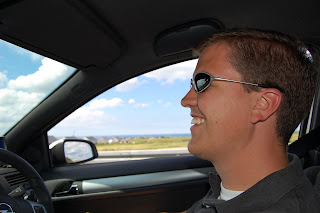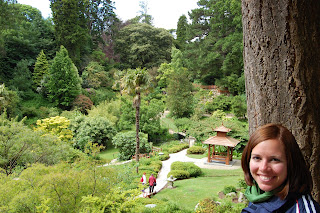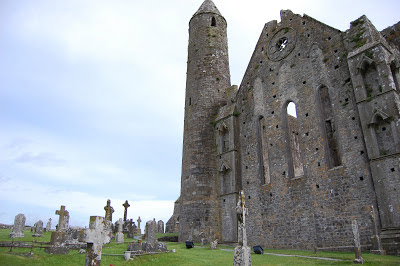We had another free weekend in England (which conveniently happened to be 5 days before our 4th anniversary), so we booked a few B&Bs, rented a car, and headed north.
Friday, July 10th - Cotswolds
The Cotswolds is a loosely bordered area an hour or so from London where all the Londoners go for a weekend break. If you had to pick one word to describe it, it would be "quaint". When you think of English country villages, the picture that comes to mind was taken in the Cotswolds.
I left work early on Friday and we made our first stop at Blenheim Palace. This is a giant house and gardens built by the king for the 1st Duke of Marlborough, John Churchill. He earned his fortune and title by winning some key battles for England back around the 1700s. Since then, the home has passed down through the family, who have squandered what was once a ridiculous fortune, to where now the 11th Duke lives in the East Wing and rents the rest to tourists who want to have a look.

The palace was nice, especially the gardens. Not as nice as some that we've seen, and bit on the expensive side (especially knowing that at least some of the money went to fund the lavish lifestyle of the guy living down the hall). The most interesting part is the connection to Sir Winston Churchill. He was in the bloodline of the original Duke, though not a direct heir. He had a huge connection to the place - he was actually born there when his parents were at a Christmas party and she went into early labor. He got engaged and married there, spent several holidays visiting his cousin the Duke there, and is now buried on the grounds.

The palace was nice, especially the gardens. Not as nice as some that we've seen, and bit on the expensive side (especially knowing that at least some of the money went to fund the lavish lifestyle of the guy living down the hall). The most interesting part is the connection to Sir Winston Churchill. He was in the bloodline of the original Duke, though not a direct heir. He had a huge connection to the place - he was actually born there when his parents were at a Christmas party and she went into early labor. He got engaged and married there, spent several holidays visiting his cousin the Duke there, and is now buried on the grounds.
After leaving the palace, we headed to our B&B in Stow-on-the Wold. It was a nice little place called Tall Trees Stow that was a working farm, complete with chickens, horses, a rabbit, and a black lab. We walked through the little town, peeking into all the windows of the small shops that had closed earlier in the evening. The shops were heavy on the antiques and hand-made woolen attire, which added to the quaintness. There was even a candy shop with the window full of old-timey candy jars filled to the brim with delightful goodies (it was a good thing this one was closed).

After checking out the town, we had dinner in a local pub and headed back to the B&B to call it a night.
Saturday, July 11th - More Cotswolds
Saturday was mainly spent driving around the area. There are tons of little towns throughout the area, so we drove from town to town, walking around a few of the towns and stopping off at a few of the sites. It was really nice to see the country. It is a completely different side of England from what you see in big-city London. Here are a few of the highlights:
- Cotswold Farm Park - basically a petting zoo. They have dedicated themselves to protecting rare breeds, so they apparently have a lot of goats and sheep and chickens that are in danger of extinction. They pretty much all looked like goats and sheep and chickens all the same. It was very hands on, so we got to pet some piglets and rabbits and of course the goats. The best part was when Jenna was holding a baby chick, and her giant smile turned quickly to frown as the bird relieved itself in her palm!!



- Snowshill Lavender - An enormous field of lavender. Purple everywhere. I think the point is that you frolic through the fields. I wasn't much for frolicing, and Jenna was slightly afraid of the thousands of bees, so we probably didn't take full advantage.
- Stratford-Upon-Avon - Birthplace and sometimes home of William Shakespeare. We visited his birthplace (although there were lots of, "we thinks", so who knows). We walked around the town, which was nice aside from the thousands of other tourists. Probably good for the hard core fans of the poet, but if you're looking for a nice town to visit, the others in the Cotswolds are much better.



North Wales - Saturday and Sunday, July 11-12
I'm not sure how to describe Wales. It is sort of a country, except that its not. It is a separate territory within the UK, but they have no separate government or anything. Anyway, it is on the West coast of the country, in the central section.
We drove up on Saturday evening and got to the town of Ruthin in time to make our reservations for a medieval dinner. The town's castle was converted into a fancy hotel, and the restaurant puts on a dinner show a couple of times a week. The grub was similar to what you'd find at Medieval Times, but the venue is much smaller, like a small banquet hall would have been in the original castle. They then put on a somewhat silly "murder mystery" show. In all it was about what you'd expect - overpriced but a lot of fun.


Sunday morning we enjoyed a good breakfast at grandma's B&B. This B&B was outside of the town and we could tell that not many people drop by. The couple running it had grandkids just younger than us, and since we were the only ones there it really felt like we were visiting the grandparents for the weekend.
The rest of the day was spent driving around to a few of the main towns in North Wales, which has nice scenery and the greatest concentration of castles in the UK. Again, here's the highlights:
- Conwy town and Castle - We had a few problems getting our bearings here, and we got lost finding our way, but eventually we made it into the town. It was a small town with a castle built by the King of England to suppress uprisings in the newly conquered Wales (like most of the castles here). We enjoyed walking around and seeing the small shops. The castle was nice but mostly ruined. Our favorite place was the official smallest house in Great Britain. It was outrageously small, literally having enough room for a bed in the loft and a sink and bench seat in the entrance.
- Llanfairpwllgwyngyllgogerychwyrndrobwllllantysiliogogogoch - No, that is not a typo. Those 58 letters (including 4 "L's" in a row) make up the longest town name in Europe (in Welsh), and we've been there and taken a picture of the sign. The translation is actually about 23 words, and was given the name just so that it could get the title, but I guess it got us to visit. Interestingly - the longest named town in the world is 163 letters, and is in Thailand.
- Caernarfon Castle - This is the biggest castle in the area, and was built as a palace for the King of England when he visited. Apparently due to a lack of money, it was never completed, so there are stones jutting out from walls that were originally designed to be a full wall, that was just never finished. This place is famous for the place where the final agreement between the English and the Welsh took place, as the King agreed that if they'd quit fighting, he'd give them a prince that was born in Wales and spoke no English. The idea was that he would speak Welsh instead (which was important to them), but as the story goes, the King brought his wife there to give birth, held him up and said, "Here is my Welsh-born son, and as I promised, he speaks no English". He soon after took his family back to England to raise the prince. Anyway, the "deal" has stuck, and generally the heir is given the title "Prince of Wales" and is given his entitlement at this castle. There is also a round platform on the castle grounds where Prince Charles was crowned Prince of Wales.



We had a long drive back to London, so we flipped on the UK Top 40 (very Michael Jackson heavy at the time) and made our way home.






 I read Oliver Twist by the great Mr. Dickens (who is an English national hero, by the way), a little more than a year ago. They've been playing the musical version here for a while, but around Christmas the lead role (which in the play version is not Oliver) was taken over by Rowan Atkinson. Yes, that's Mr. Bean. Since I enjoyed the book and we thought it would be funny to see him. We had to go.
I read Oliver Twist by the great Mr. Dickens (who is an English national hero, by the way), a little more than a year ago. They've been playing the musical version here for a while, but around Christmas the lead role (which in the play version is not Oliver) was taken over by Rowan Atkinson. Yes, that's Mr. Bean. Since I enjoyed the book and we thought it would be funny to see him. We had to go. You can guess who wanted to go see this one.
You can guess who wanted to go see this one. (note: this photo was stolen from Eric and Anne. Our seats were down in the corner, and their pictures came out a lot better - although since I stole it offline, it is a little pixel-y)
(note: this photo was stolen from Eric and Anne. Our seats were down in the corner, and their pictures came out a lot better - although since I stole it offline, it is a little pixel-y) The original Globe burned down in one of the many great fires that London has seen, but was rebuilt in the recent past. You can visit year round, but in the summer plays are put on by the Royal Shakespeare Academy (which is where a many famous
The original Globe burned down in one of the many great fires that London has seen, but was rebuilt in the recent past. You can visit year round, but in the summer plays are put on by the Royal Shakespeare Academy (which is where a many famous 











































